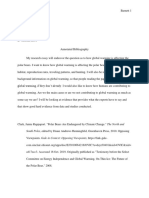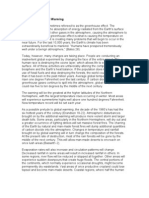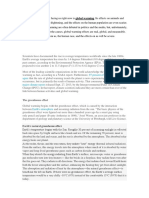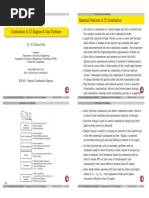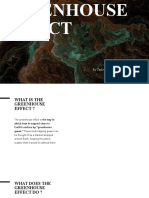Global War
Global War
Uploaded by
ARUNGREESMACopyright:
Available Formats
Global War
Global War
Uploaded by
ARUNGREESMAOriginal Description:
Copyright
Available Formats
Share this document
Did you find this document useful?
Is this content inappropriate?
Copyright:
Available Formats
Global War
Global War
Uploaded by
ARUNGREESMACopyright:
Available Formats
Indian Journal of Science and Technology
Vol. 4 issue 3 (March 2011)
226
ISSN: 0974- 6846
Causes and effects of global warming
M. Venkataramanan and Smitha
Department of Economics, D.G. Vaishnav College, Chennai, India
smitha_05@rediffmail.com
Abstract
Global warming is defined as the increase of the average temperature on Earth. As the Earth is getting hotter,
disasters like hurricanes, droughts and floods are getting more frequent. Over the last 100 years, the average air
temperature near the Earths surface has risen by a little less than 1 degree Celsius or 1.3 degrees Fahrenheit.
Deforestation increases the severity of global warming. The ocean is a huge carbon sink, holding about 50 times as
much carbon as the atmosphere. The oceans are no longer able to store carbon as they have in the past. Burning
fossil fuels such as natural gas, coal, oil and gasoline raises the level of carbon dioxide in the atmosphere, and
carbon dioxide is a major contributor to the greenhouse effect and global warming. The climate change would
increase the number of people suffering from death, disease and injury from heatwaves, floods, storms and
droughts. Floods are low-probability, high-impact events that can overwhelm physical infrastructure and human
communities. Major storm and flood disasters have occurred in the last two decades. One can help to reduce the
demand for fossil fuels, which in turn reduces global warming, by using energy more wisely.
Keywords: Global warming, fossil fuels, methane.
Introduction
Global Warming is defined as the increase of the
average temperature on Earth. As the Earth is getting
hotter, disasters like hurricanes, droughts and floods are
getting more frequent.Over the last 100 years, the
average air temperature near the Earths surface has
risen by a little less than 1 degree Celsius or 1.3
degrees Fahrenheit. Global warming is the cause,
climate change is the effect. Scientists often prefer to
speak about climate change instead of global warming,
because higher global temperatures dont necessarily
mean that it will be warmer at any given time at every
location on Earth. Warming is strongest at the Earth's
Poles, the Arctic and the Antarctic, and will continue to
be so. In recent years, fall air temperatures have been
at a record 9 degrees Fahrenheit (5 degrees Celsius)
above normal in the Arctic, according to the U.S.
National Oceanic and Atmospheric Administration. But
changing wind patterns could mean that a warming
Arctic, for example, leads to colder winters in continental
Europe. Regional climates will change as well, but in
very different ways. Some regions like parts of Northern
Europe or West Africa will probably get wetter, while
other regions like the Mediterranean or Central Africa
will most likely receive less rainfall. Melting ice is the
most visible impact of a warming climate. The UN Panel
on Climate Change finds that average Arctic
temperatures have increased at almost twice the global
average rate in the past 100 years.
Green House Effect: When sunlight reaches Earth's
surface some is absorbed and warms the earth and
most of the rest is radiated back to the atmosphere at a
longer wavelength than the sun light. Some of these
longer wavelengths are absorbed by greenhouse gases
in the atmosphere before they are lost to space. The
absorption of this long wave radiant energy warms the
atmosphere. These greenhouse gases act like a mirror
and reflect back to the Earth some of the heat energy
which would otherwise be lost to space. The reflecting
back of heat energy by the atmosphere is called the
"greenhouse effect". The major natural greenhouse
gases are water vapor, which causes about 36-70% of
the greenhouse effect on Earth (not including clouds);
carbon dioxide CO2, which causes 9-26%; methane,
which causes 4-9%, and ozone, which causes 3-7%. It
is not possible to state that a certain gas causes a
certain percentage of the greenhouse effect, because
the influences of the various gases are not additive.
Other greenhouse gases include, but are not limited to,
nitrous oxide, sulfur hexafluoride, hydrofluorocarbons,
perfluorocarbons and chlorofluorocarbons. Almost
100% of the observed temperature increase over the
last 50 years has been due to the increase in the
atmosphere of greenhouse gas concentrations like
water vapour, carbon dioxide (CO2), methane and
ozone. Greenhouse gases are those gases that
contribute to the greenhouse effect (Fig. 1). The largest
contributing source of greenhouse gas is the burning of
fossil fuels leading to the emission of carbon dioxide.
Causes of global warming: The buildup of carbon
dioxide in the atmosphere, mainly from your fossil fuel
emissions, is the most significant human cause of global
warming. Carbon dioxide is released every you burn
something, be it a car, airplane or coal plant. This
means you must burn less fossil fuel if you want the
Earth's climate to remain stable! And unfortunately, we
are currently destroying some of the best known
mechanisms
for
storing
that
carbonplants.
Deforestation increases the severity of global warming
as well. Carbon dioxide is released from the human
Proceedings of the Global Environmental and its sustainability: Implications and Strategies held at Chennai, India (7th Nov.2010) & Bangkok, Thailand (25th-29th Nov.2010)
Indian Society for Education and Environment (iSee)
http://www.indjst.org
Indian J.Sci.Technol.
Indian Journal of Science and Technology
conversion of forests and grasslands into farmland and
cities. All living plants store carbon. When those plants
die and decay, carbon dioxide is released back into the
atmosphere. As forests and grasslands are cleared for
your use, enormous amounts of stored carbon enter the
atmosphere. An unstoppable feedback loop may
happen if you let this continue. If the activities
mentioned above warm the Earth just enough, it could
cause natural carbon sinks to fail. A "carbon sink" is a
natural system that stores carbon over thousands of
years. Such sinks include peat bogs and the arctic
tundra. But if these sinks destabilize, that carbon will be
released, possibly causing an unstoppable and
catastrophic warming of the Earth. The oceans are no
longer able to store carbon as they have in the past. The
ocean is a huge carbon sink, holding about 50 times as
much carbon as the atmosphere. But now scientists are
realizing that the increased thermal stratification of the
oceans has caused substantial reductions in levels of
phytoplankton, which store CO2. Increased atmospheric
carbon is also causing an acidification of the ocean,
since carbon dioxide forms carbonic acid when it reacts
with water. The tiny plants of the ocean, the very bottom
of that vast watery food chain, are suffering from the
effects of global warming, which means they are
becoming less able to store carbon, further contributing
to climate change. As carbon sinks fail, the amount of
carbon in the atmosphere climbs!
Methane's huge impact: Methane is created when
bacteria break down organic matter under oxygenstarved conditions. This occurs when organic matter is
trapped underwater, as in rice paddies. It also takes
place in the intestines of herbivorous animals, such as
cows, sheep, and goats. Because human agriculture
has grown over time to engulf most of the arable land on
the planet, it is now adding a lot of methane to the
atmosphere. Landfills and leakage from natural gas
fields (methane is a component of natural gas) are also
significant sources of methane. Clathrates are a hidden
source of Methane. Clathrates are frozen chunks of ice
and methane that rest at the bottom of the world's
oceans. As the water warms, the ice melts, and the
methane is released. If the current global warming,
which is caused by humans, were to cause changes in
the Earth's ocean currents, then a rapid melting of
clathrates would be possible. This too would create a
positive feedback loop that would cause further global
warming. It is believed that some of the warming cycles
in the Earth's history have been caused by the sudden
thawing of clathrates.
A growing problem
The "green revolution" of the twentieth century has
allowed the farmers of the world to use chemical
fertilizers and machines to produce far more food than
they ever did before. One of the primary components of
the green revolution has been the development of
Vol. 4 issue 3 (March 2011)
227
ISSN: 0974- 6846
nitrogen fertilizers that dramatically accelerate the
growth and productivity of plants in the field. Plants "fix,"
or capture, nitrogen on their own as well, but green
revolution technologies have become so popular that
humans are now adding more nitrogen to the earth than
all of the plants in the world combined.
Effects of global warming:
Increasing global temperatures are causing a broad
range of changes. Sea levels are rising due to thermal
expansion of the ocean, in addition to melting of land
ice. Amounts and patterns of precipitation are changing.
The total annual power of hurricanes has already
increased markedly since 1975 because their average
intensity and average duration have increased (in
addition, there has been a high correlation of hurricane
power with tropical sea-surface temperature). Changes
in temperature and precipitation patterns increase the
frequency, duration, and intensity of other extreme
weather events, such as floods, droughts, heat waves,
and tornadoes. Other effects of global warming include
higher or lower agricultural yields, further glacial retreat,
reduced summer stream flows, species extinctions. As a
further effect of global warming, diseases like malaria
are returning into areas where they have been
extinguished earlier. Although global warming is
affecting the number and magnitude of these events, it
is difficult to connect specific events to global warming.
Although most studies focus on the period up to 2100,
warming is expected to continue past then because
carbon dioxide (chemical symbol CO2) has an estimated
atmospheric lifetime of 50 to 200 years.
Effects on weather:
Increasing temperature is likely to lead to increasing
precipitation but the effects on storms are less clear.
Extratropical storms partly depend on the temperature
gradient, which is predicted to weaken in the northern
hemisphere as the polar region warms more than the
rest of the hemisphere. Regional effects of global
warming vary in nature. Some are the result of a
generalised global change, such as rising temperature,
resulting in local effects, such as melting ice. In other
cases, a change may be related to a change in a
particular ocean current or weather system. In such
cases, the regional effect may be disproportionate and
will not necessarily follow the global trend. There are
three major ways in which global warming will make
changes to regional climate: melting or forming ice,
changing the hydrological cycle (of evaporation) and
changing currents in the oceans and air flows in the
atmosphere. The coast can also be considered a region,
and will suffer severe impacts from sea level rise.
Glacier retreat and disappearance:
Mountain glaciers and snow cover had decreased in
both the northern and southern hemispheres. This
widespread decrease in glaciers and ice caps has
Proceedings of the Global Environmental and its sustainability: Implications and Strategies held at Chennai, India (7th Nov.2010) & Bangkok, Thailand (25th-29th Nov.2010)
Indian Society for Education and Environment (iSee)
http://www.indjst.org
Indian J.Sci.Technol.
Indian Journal of Science and Technology
contributed to observed sea level rise. Predictions
relating to future changes in glaciers.
x Mountainous areas in Europe will face glacier retreat
x In Latin America, changes in precipitation patterns
and the disappearance of glaciers will significantly
affect water availability for human consumption,
agriculture, and energy production
x In Polar regions, there will be reductions in glacier
extent and the thickness of glaciers.
Vol. 4 issue 3 (March 2011)
228
ISSN: 0974- 6846
Fig. 1. Annual greenhouse gas emission by sector.
Oceans:
The role of the oceans in global warming is a
complex one. The oceans serve as a sink for carbon
dioxide, taking up much that would otherwise remain in
the atmosphere, but increased levels of CO2 have led to
ocean acidification. Furthermore, as the temperature of
the oceans increases, they become less able to absorb
excess CO2. Global warming is projected to have a
number of effects on the oceans. Ongoing effects
include rising sea levels due to thermal expansion and
melting of glaciers and ice sheets, and warming of the
ocean surface, leading to increased temperature
stratification. Other possible effects include large-scale
changes in ocean circulation.
Health:
Human beings are exposed to climate change
through changing weather patterns (temperature,
precipitation, sea-level rise and more frequent extreme
events) and indirectly through changes in water, air and
food quality and changes in ecosystems, agriculture,
industry and settlements and the economy. The effects
of climate change to date have been small, but are
projected to progressively increase in all countries and
regions. It is concluded that climate change had altered
the seasonal distribution of some allergenic pollen
species. With medium confidence, they concluded that
climate change had altered the distribution of some
infectious disease vectors and increased heat waverelated deaths.
Measures to reduce global warming
Burning fossil fuels such as natural gas, coal, oil and
gasoline raises the level of carbon dioxide in the
atmosphere, and carbon dioxide is a major contributor
to the greenhouse effect and global warming. You can
help to reduce the demand for fossil fuels, which in turn
reduces global warming, by using energy more wisely.
Here are 10 simple actions you can take to help reduce
global warming.
1. Reduce, Reuse, Recycle: Do your part to reduce
waste by choosing reusable products instead of
disposables. Buying products with minimal packaging
(including the economy size when that makes sense for
you) will help to reduce waste. And whenever you can,
recycle paper, plastic, newspaper, glass and aluminum
cans. If there isn't a recycling programe at your
workplace, school, or in your community, ask about
starting one. By recycling half of your household waste,
you can save 2,400 pounds of carbon dioxide annually.
2. Use Less Heat and Air Conditioning: Adding
insulation to your walls and attic, and installing weather
stripping or caulking around doors and windows can
lower your heating costs more than 25 percent, by
reducing the amount of energy you need to heat and
cool your home. Turn down the heat while you're
sleeping at night or away during the day, and keep
temperatures moderate at all times. Setting your
thermostat just 2 degrees lower in winter and higher in
summer could save about 2,000 pounds of carbon
dioxide each year.
3. Change a light bulb: Wherever practical, replace
regular light bulbs with compact fluorescent light (CFL)
bulbs. Replacing just one 60-watt incandescent light
bulb with a CFL will save you $30 over the life of the
bulb. CFLs also last 10 times longer than incandescent
bulbs, use two-thirds less energy, and give off 70
percent less heat. If every U.S. family replaced one
regular light bulb with a CFL, it would eliminate 90 billion
pounds of greenhouse gases, the same as taking 7.5
million cars off the road.
4. Drive less and drive smart: Less driving means fewer
emissions. Besides saving gasoline, walking and biking
are great forms of exercise. Explore your community
mass transit system, and check out options for
carpooling to work or school. When you do drive, make
sure your car is running efficiently. For example,
keeping your tries properly inflated can improve your
gas mileage by more than 3 percent. Every gallon of gas
you save not only helps your budget, it also keeps 20
pounds of carbon dioxide out of the atmosphere.
5. Buy Energy-Efficient Products: When it's time to buy
a new car, choose one that offers good gas mileage.
Home appliances now come in a range of energy-
Proceedings of the Global Environmental and its sustainability: Implications and Strategies held at Chennai, India (7th Nov.2010) & Bangkok, Thailand (25th-29th Nov.2010)
Indian Society for Education and Environment (iSee)
http://www.indjst.org
Indian J.Sci.Technol.
Indian Journal of Science and Technology
efficient models, and compact florescent bulbs are
designed to provide more natural-looking light while
using far less energy than standard light bulbs. Avoid
products thatcome with excess packaging, especially
molded plastic and other packaging that can't be
recycled. If you reduce your household garbage by 10
percent, you can save 1,200 pounds of carbon dioxide
annually.
6. Use Less Hot Water: Set your water heater at 120
degrees to save energy, and wrap it in an insulating
blanket if it is more than 5 years old. Buy low-flow
showerheads to save hot water and about 350 pounds
of carbon dioxide yearly. Wash your clothes in warm or
cold water to reduce your use of hot water and the
energy required to produce it. That change alone can
save at least 500 pounds of carbon dioxide annually in
most households. Use the energy-saving settings on
your dishwasher and let the dishes air-dry.
7. Use the "Off" Switch: Save electricity and reduce
global warming by turning off lights when you leave a
room, and using only as much light as you need. And
remember to turn off your television, video player,
stereo and computer when you're not using them. It's
also a good idea to turn off the water when you're not
using it. While brushing your teeth, shampooing the dog
or washing your car, turn off the water untilyou actually
need it for rinsing. You'll reduce your water bill and help
to conserve a vital resource.
8. Plant a tree: If you have the means to plant a tree,
start digging. During photosynthesis, trees and other
plants absorb carbon dioxide and give off oxygen. They
are an integral part of the natural atmospheric exchange
cycle here on Earth, but there are too few of them to
fully counter the increases in carbon dioxide caused by
automobile traffic, manufacturing and other human
activities. A single tree will absorb approximately one
ton of carbon dioxide during its lifetime.
9. Get a report card from your utility company: Many
utility companies provide free home energy audits to
help consumers identify areas in their homes that may
not be energy efficient. In addition, many utility
companies offer rebate programs to help pay for the
cost of energy-efficient upgrades.
10. Encourage Others to Conserve: Share information
about recycling and energy conservation with your
friends, neighbors and co-workers, and take
opportunities to encourage public officials to establish
programs and policies that are good for the
environment. These 10 steps will take you a long way
toward reducing your energy use and your monthly
budget. And less energy use means less dependence
on the fossil fuels that create greenhouse gases and
contribute to global warming.
Vol. 4 issue 3 (March 2011)
229
ISSN: 0974- 6846
Conclusion
The climate change would increase the number of
people suffering from death, disease and injury from
heat waves, floods, storms and droughts. Floods are
low-probability, high-impact events that can overwhelm
physical infrastructure and human communities. Major
storm and flood disasters have occurred in the last two
decades. Vulnerability to weather disasters depends on
the attributes of the person at risk, including where they
live and their age, as well as other social and
environmental factors. High-density populations in lowlying coastal regions experience a high health burden
from weather disasters. Hot days, hot nights and heat
waves have become more frequent. Heat waves are
associated with marked short-term increases in
mortality. In some regions, changes in temperature and
precipitation are projected to increase the frequency and
severity of fire events . Forest and bush fires cause
burns, damage from smoke inhalation and other injuries.
Background levels of ground-level ozone have risen
since pre-industrial times because of increasing
emissions of methane, carbon monoxide and nitrogen
oxides .This trend is expected to continue into the mid21st century.
Proceedings of the Global Environmental and its sustainability: Implications and Strategies held at Chennai, India (7th Nov.2010) & Bangkok, Thailand (25th-29th Nov.2010)
Indian Society for Education and Environment (iSee)
http://www.indjst.org
Indian J.Sci.Technol.
You might also like
- Global Warming Assignment (Final)Document8 pagesGlobal Warming Assignment (Final)Howard How100% (4)
- Global WarmingDocument12 pagesGlobal Warmingshoeb100% (1)
- Expository Essay - Global Warming 2Document4 pagesExpository Essay - Global Warming 2Ong Szechuan67% (9)
- Annotated Bibliography SinclairDocument16 pagesAnnotated Bibliography Sinclairapi-483644981No ratings yet
- Global Warming Is The Term Used To Describe A Gradual Increase in The Average Temperature of The EarthDocument6 pagesGlobal Warming Is The Term Used To Describe A Gradual Increase in The Average Temperature of The EarthSaswataBhattacharyaNo ratings yet
- Global Warming Is A Gradual Increase in The EarthDocument47 pagesGlobal Warming Is A Gradual Increase in The EarththaoNo ratings yet
- Fossil FuelsDocument4 pagesFossil FuelsAlexPeterNo ratings yet
- The Earth Is Warming and Places Are BurningDocument4 pagesThe Earth Is Warming and Places Are BurningGrechlyanne Amaneci CasmoNo ratings yet
- Untitled Environmental Economics UnitDocument10 pagesUntitled Environmental Economics UnitVaishali JoshiNo ratings yet
- Climate ConditionsDocument22 pagesClimate Conditionsbhatianitika806No ratings yet
- Bono, Leo Joselito E. EH406Document4 pagesBono, Leo Joselito E. EH406Rash Ibno PundingNo ratings yet
- Evs Unit2Document36 pagesEvs Unit2Reena GharatNo ratings yet
- Global Warming and Climate ChangeDocument10 pagesGlobal Warming and Climate ChangeMuhammad WaseemNo ratings yet
- Climate ChangeDocument4 pagesClimate ChangeDee-Kay JoricNo ratings yet
- Climate Change and Its EffectsDocument13 pagesClimate Change and Its EffectsRajpoot KhanNo ratings yet
- Climate Change - 240523 - 131500Document5 pagesClimate Change - 240523 - 131500Sidra SaeedNo ratings yet
- Climate Change EssayDocument3 pagesClimate Change EssayKd123No ratings yet
- REPORT ON Global WarmingDocument21 pagesREPORT ON Global WarmingScribdTranslationsNo ratings yet
- Did You Know?Document4 pagesDid You Know?Miguel FernandesNo ratings yet
- Global WarmingDocument5 pagesGlobal WarmingjefriNo ratings yet
- INS 101 Assignment - BodyDocument13 pagesINS 101 Assignment - BodyDarek ShephardNo ratings yet
- Global Warming Begins When Sunlight Reaches EarthDocument10 pagesGlobal Warming Begins When Sunlight Reaches Earthamitpardeshi441407No ratings yet
- Global WarmingDocument7 pagesGlobal WarmingHardik TankNo ratings yet
- Global WarmingDocument33 pagesGlobal WarmingAnup Das100% (1)
- Green House Effect & Global WarmingDocument5 pagesGreen House Effect & Global WarmingAnanya SharmaNo ratings yet
- Commented (U1) : BURNING FOSSIL FUELDocument2 pagesCommented (U1) : BURNING FOSSIL FUELBusiness OnlyNo ratings yet
- STS Notes On Climate ChangeDocument2 pagesSTS Notes On Climate Changetabeb chanNo ratings yet
- Causes of Changing Weather PatternsDocument6 pagesCauses of Changing Weather PatternsEtunEvelynNo ratings yet
- "The Effects of Global Warming": Mrs. Elenor May Chantal L. MessakaraengDocument11 pages"The Effects of Global Warming": Mrs. Elenor May Chantal L. Messakaraengzitadewi435No ratings yet
- Unit 4Document28 pagesUnit 4Vaishali JoshiNo ratings yet
- The Threat of Global WarmingDocument11 pagesThe Threat of Global WarmingHarish SharmaNo ratings yet
- Unit-I Notes of Env. Management PDFDocument12 pagesUnit-I Notes of Env. Management PDFJaskirat SinghNo ratings yet
- EconDocument20 pagesEconZhamee LahNo ratings yet
- Geo Essay (10 Marks)Document3 pagesGeo Essay (10 Marks)Ari 05No ratings yet
- Greenhouse Effect: Global Climate ChangeDocument5 pagesGreenhouse Effect: Global Climate ChangeyskstogtyNo ratings yet
- Environmental Science Study MaterialDocument24 pagesEnvironmental Science Study MaterialEren YeagerNo ratings yet
- 97 Percent of Climate Scientists Agree A Major Climate ReportDocument5 pages97 Percent of Climate Scientists Agree A Major Climate ReportGean Rose CanceranNo ratings yet
- Environmental LawsDocument9 pagesEnvironmental LawsPrajwal BharadwajNo ratings yet
- Climate Change Fact SheetDocument5 pagesClimate Change Fact SheetZrmynx Di ArrantNo ratings yet
- What Are The Reasons For Global Warming?Document6 pagesWhat Are The Reasons For Global Warming?manirathinaNo ratings yet
- Climate Change and Its EffectsDocument8 pagesClimate Change and Its Effectsapi-608131489No ratings yet
- TUGAS Global WarmingDocument4 pagesTUGAS Global WarmingPolsek Siantar SelatanNo ratings yet
- Unit 5Document25 pagesUnit 5A BhNo ratings yet
- Global Warming, Sustainable Architecture and Architect's RoleDocument15 pagesGlobal Warming, Sustainable Architecture and Architect's Roletejasi gadkari100% (5)
- Essay On Global WarmingDocument9 pagesEssay On Global WarmingScribdTranslationsNo ratings yet
- Gobal WarmingDocument7 pagesGobal WarmingKamlesh SharmaNo ratings yet
- Clima AmbientalDocument19 pagesClima Ambientalguhevm22p11No ratings yet
- (SPEECH) A Short Speech On Global WarmingDocument1 page(SPEECH) A Short Speech On Global WarmingMarius Villanueva100% (1)
- Climate Change Is UnequivocalDocument8 pagesClimate Change Is UnequivocalRajan Bhatt, Ph.D (Soil Science)No ratings yet
- The Greenhouse Effect and Thinning of The Ozone Layer On The EcosystemDocument21 pagesThe Greenhouse Effect and Thinning of The Ozone Layer On The EcosystemShahirah NsnNo ratings yet
- Climate ChangeDocument18 pagesClimate ChangeKhushnuma ParveenNo ratings yet
- Global WarmingDocument11 pagesGlobal WarmingAmin BassitNo ratings yet
- 5 - 1 - Climate Change and Global WarmingDocument5 pages5 - 1 - Climate Change and Global Warmingzoafanai033No ratings yet
- Gas and Environment Pollution: Global WarmingDocument6 pagesGas and Environment Pollution: Global Warmingadeelafzal_00162No ratings yet
- Climate Change Global Warming Acid Rain Ozone Layer DepletionDocument3 pagesClimate Change Global Warming Acid Rain Ozone Layer Depletiontaiba shamsNo ratings yet
- Is Global Warming Causing Severe Weather?: Student Name Instructor Name Course Name DateDocument10 pagesIs Global Warming Causing Severe Weather?: Student Name Instructor Name Course Name DatevedanjaliNo ratings yet
- EssayDocument75 pagesEssayMonaliza BulayangNo ratings yet
- Unit-4 Notes EvsDocument21 pagesUnit-4 Notes Evsjakshat086No ratings yet
- Global Warming Is Caused by Green House GasesDocument17 pagesGlobal Warming Is Caused by Green House Gasesrohit86dhingraNo ratings yet
- Understanding Global Warming with Max Axiom Super Scientist: 4D An Augmented Reading Science ExperienceFrom EverandUnderstanding Global Warming with Max Axiom Super Scientist: 4D An Augmented Reading Science ExperienceNo ratings yet
- Vanishing Peaks: Unveiling the Impact of Climate Change on Global SnowpacksFrom EverandVanishing Peaks: Unveiling the Impact of Climate Change on Global SnowpacksNo ratings yet
- Importance of Measurement On Science & TechnologyDocument14 pagesImportance of Measurement On Science & TechnologyARUNGREESMANo ratings yet
- Maximizing Auditory SlidesDocument18 pagesMaximizing Auditory SlidesARUNGREESMANo ratings yet
- ME401 Combustion CIDocument6 pagesME401 Combustion CIBalvinderNo ratings yet
- Thermal II Lab Manual AnnauniversityDocument77 pagesThermal II Lab Manual AnnauniversityAravindha KrishnaNo ratings yet
- Total Points Noted in Each Section Must Clearly Show Equations With Values and Units, Drawings, Assumptions, Etc.Document7 pagesTotal Points Noted in Each Section Must Clearly Show Equations With Values and Units, Drawings, Assumptions, Etc.ARUNGREESMANo ratings yet
- Sri Ramakrishna Institute of Technology, Coimbatore - 10Document2 pagesSri Ramakrishna Institute of Technology, Coimbatore - 10ARUNGREESMANo ratings yet
- Pulveriser-Power PlantDocument67 pagesPulveriser-Power PlantARUNGREESMANo ratings yet
- Solar Heat Reflective CoatingsDocument2 pagesSolar Heat Reflective CoatingsARUNGREESMANo ratings yet
- Power PlantDocument24 pagesPower PlantARUNGREESMANo ratings yet
- Power PlantDocument68 pagesPower Plantvinoddeswal057No ratings yet
- Drawdown The Most Comprehensive Plan Ever Proposed To 22mukbc89sDocument1 pageDrawdown The Most Comprehensive Plan Ever Proposed To 22mukbc89sGary Angulo100% (1)
- Greenhouse Gases and Global Warming EXAM QUESTIONSDocument4 pagesGreenhouse Gases and Global Warming EXAM QUESTIONSph55krrgpnNo ratings yet
- Greenhouse Effect PowerpointDocument16 pagesGreenhouse Effect Powerpointsky animal girlNo ratings yet
- REVIEW 2 Unit 4 5 KEYDocument5 pagesREVIEW 2 Unit 4 5 KEYThảo Vy100% (3)
- Multisplit Airconditioning System PDFDocument21 pagesMultisplit Airconditioning System PDFcolleen bergancia100% (1)
- Rhetorical AnalysisDocument5 pagesRhetorical Analysisapi-3565651850% (2)
- 2 - Climate and ChangeDocument3 pages2 - Climate and ChangeMROHANLONNo ratings yet
- Greta Thunberg UN Climate Action Summit Speech Transcript 2019Document1 pageGreta Thunberg UN Climate Action Summit Speech Transcript 2019Rowena Delima Espinosa100% (1)
- Global Warming SpeechDocument3 pagesGlobal Warming SpeechHussnain AliNo ratings yet
- EnvironmentDocument5 pagesEnvironmentBiswajeet RoutNo ratings yet
- Ekanade Et Al - NigeriaDocument9 pagesEkanade Et Al - NigeriammacmacNo ratings yet
- Presentation on Climate Resilient Infrastructures 1713129396Document13 pagesPresentation on Climate Resilient Infrastructures 1713129396abdulqudos.alghabbanNo ratings yet
- IELTS Reading Matching HeadingsDocument2 pagesIELTS Reading Matching HeadingsBrahim Idbendriss100% (1)
- Global Cooling - A PPT by SAHAS.SDocument34 pagesGlobal Cooling - A PPT by SAHAS.SSahas Sathya100% (3)
- Issues in Canada CH 9 TextbookDocument41 pagesIssues in Canada CH 9 Textbookapi-181174123No ratings yet
- Media Release - International Criminal Court Complaint - Donald Trump and Scott PruittDocument3 pagesMedia Release - International Criminal Court Complaint - Donald Trump and Scott PruittWhitfield Larrabee100% (1)
- Greenhouse Effect PDFDocument4 pagesGreenhouse Effect PDFJesabel Mahinay SinggaNo ratings yet
- Geography FOR UPSCDocument6 pagesGeography FOR UPSCSanjeev PrakashNo ratings yet
- LS2 Science DLP-AE-JHS (Global Warming and Climate Change)Document6 pagesLS2 Science DLP-AE-JHS (Global Warming and Climate Change)Ameil EscalaNo ratings yet
- GLOBAL WARMING Presentation SlideDocument21 pagesGLOBAL WARMING Presentation SlideranggaNo ratings yet
- Sea Level Rise - A Global Problem in Your BackyardDocument13 pagesSea Level Rise - A Global Problem in Your BackyardGunawan La OdeNo ratings yet
- Global Conference On Strengthening Synergies Between The Paris Agreement On Climate Change and The 2030 Agenda For Sustainable DevelopmentDocument99 pagesGlobal Conference On Strengthening Synergies Between The Paris Agreement On Climate Change and The 2030 Agenda For Sustainable DevelopmentJonathan FletesNo ratings yet
- Ipcc Special Report " Global Warming of 1.5°C ": Summary For TeachersDocument24 pagesIpcc Special Report " Global Warming of 1.5°C ": Summary For TeachersloungefiNo ratings yet
- Climate Resilient City Action Plan Rajshahi Report - Compressed - CompressedDocument146 pagesClimate Resilient City Action Plan Rajshahi Report - Compressed - Compressedtahatulazid.officialNo ratings yet
- Question BankDocument2 pagesQuestion BankRahulRamNo ratings yet
- Heat Wave: DefinitionDocument2 pagesHeat Wave: DefinitionDoctors FamilyNo ratings yet
- Climate Change - A Guide To The Science and RisksDocument13 pagesClimate Change - A Guide To The Science and RisksasyikinNo ratings yet
- Paris AgreementDocument23 pagesParis AgreementJett Labilles100% (1)
- Reflection PaperDocument2 pagesReflection PaperGaiusChrisA.Eva100% (1)



